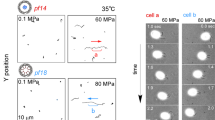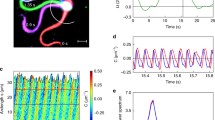Summary
Mature golden hamster sperm were demembranated with Triton X-100, and the flagellum was reactivated locally by iontophoretic application of ATP at various distances from the base. The response was a brief local straightening of a short length of the flagellum followed by the formation of a pair of bends beyond the two ends of the straight region. The two possible proximo-distal sequences of bends, either PR (principal and reverse bends) or RP, could be distinguished and their incidence studied. The formation of PR and RP bend pairs is interpreted as the result of active sliding of the axonemal doublet subsets 1–4 and 6–9 respectively. The probability of obtaining a PR response increased (1) with the initial local curvature of the resting R bend and (2) with the distance of the stimulated site from the flagellar base; it decreased with the duration of incubation after demembranation. The patterns of response in the middle and the principal piece of the flagellum were basically similar although the former was weaker and more complicated.
Quantitative analysis of the ATP-induced movements indicates little or no net microtubule displacement distal to the pair of induced bends, suggesting the cancelling of microtubule displacements in the two bends. However, the expected balance in the rate of growth of the two bends was upset by the decay of one bend simultaneously with decay of the original adjacent bend. Propagation of the interbend region started before the growth of the pair of bends reached its maximum, and seemed to be triggered by a critical bend curvature. Propagation was always in the direction base to tip. Experimental findings also suggest a role in the determination of the waveform for the fibrous structures on the periphery of the axoneme which are characteristic of the mammalian sperm flagellum.
The present study strengthens the experimental evidence for the mathematical model which proposes that active sliding occurs mainly in the interbend region and causes bending of segments in opposite directions. In addition our findings indicate that the activation of alternate halves of the axoneme is curvature dependent, suggesting a basis for the flagellar oscillation.
Similar content being viewed by others
References
BACCETTI, B., PALLINI, V. & BURRINI, A. G. (1973) Structure and chemical composition of the bull sperm ‘coarse fibers’.J. submicrosc. Cytol. 5, 237–56.
BLUM, J. J. & HAYES, A. (1978) Effects of sulphydryl reagents on the ATPase activity of solubilized 14S and 30S dyneins and on whole ciliary axonemes as a function of pH.J. Supramolec. Struct. 8, 153–71.
BROKAW, C. J. (1968) Mechanisms of sperm movement.Symp. Soc. exp. Biol. 22, 101–16.
BROKAW, C. J. (1971) Bend propagation by a sliding filament model for flagella.J. exp. Biol. 55, 289–304.
BROKAW, C. J. (1972) Flagellar movement: a sliding filament model.Science 178, 455–62.
BROKAW, C. J. (1980) Elastase digestion of sea urchin sperm flagella.Science 207, 1365–7.
BROKAW, C. J., LUCK, J. L. & HUANG, B. (1982) Analysis of the movement of Chlamydomonas flagella: the function of the radial spoke system is revealed by comparison of wild-type and mutant flagella.J. Cell Biol. 92, 722–32.
CLELAND, W. W. (1964) Dithiothreitol, a new protective reagent for SH groups.Biochemistry 3, 480–2.
FAWCETT, D. W. (1970) A comparative view of sperm ultrastructure.Biol. Reprod. Suppl.2, 90–127.
GIBBONS, B. H. & GIBBONS, I. R. (1972) Flagellar movement and adenosine triphosphatase activity in sea urchin sperm extracted with Triton X-100.J. Cell Biol. 54, 79–97.
GIBBONS, B. H., GIBBONS, I. R. & BACCETTI, B. (1983) Structure and motility of the 9+0 flagellum of eel spermatozoa.J. Submicrosc. Cytol. 15, 15–20.
GIBBONS, I. R. (1963) Studies on the protein components of cilia from Tetrahymena pyriformis.Proc. natn. Acad. Sci. 50, 1002–10.
GIBBONS, I. R. (1981) Transient flagellar waveforms during intermittent swimming in sea urchin sperm. II. Analysis of tubule sliding.J. Musc. Res. Cell Motility 2, 83–130.
GOLDSTEIN, S. F. (1976) Form of developing bends in reactivated sperm flagella.J. exp. Biol. 64, 173–84.
GOLDSTEIN, S. F. (1977) Asymmetric waveforms in echinoderm sperm flagella.J. exp. Biol. 71, 157–70.
GOLDSTEIN, S. F. (1979) Starting transients in sea urchin sperm flagella.J. Cell Biol. 80, 61–8.
GOLDSTEIN, S. F. & SCHREVEL, J. (1982) Motility of the 6+0 flagellum of Lecudina tuzetae.Cell Motility 4, 369–83.
GRAY, J. (1955) The movement of sea-urchin spermatozoa.J. exp. Biol. 32, 775–801.
LINDEMANN, C. B. & GIBBONS, I. R. (1975) Adenosine triphosphate-induced motility and sliding of filaments in mammalian sperm extracted with Triton X-100.J. Cell Biol. 65, 147–62.
MOHRI, H. & YANAGIMACHI, R. (1980) Characteristics of motor apparatus in testicular, epididymal and ejaculated spermatozoa.Expl Cell Res. 127, 191–6.
MOHRI, H. & YANO, Y. (1980) Analysis of mechanism of flagellar movement with golden hamster spermatozoa.Biomed. Res. 1, 552–5.
MORTON, B. (1973) Reactivation of progressive motility in hamster sperm modified by Triton X-100.Expl Cell Res. 79, 106–10.
OKUNO, M. & HIRAMOTO, Y. (1979) Direct measurements of the stiffness of echinoderm sperm flagella.J. exp. Biol. 79, 235–43.
OLSON, G. E. & LINCK, R. W. (1977) Observation on the structural components of flagellar axonemes and central pair microtubules from rat sperm.J. Ultrastruct. Res. 61, 21–43.
OLSON, G. E. & SAMMONS, D. W. (1980) Structural chemistry of outer dense fibers of rat sperm.Biol. Reprod. 22, 319–32.
PURVES, R. D. (1981)Microelectrode Methods for Intracellular Recording and Ionophoresis. New York, London: Academic Press.
SALE, W. S. & SATIR, P. (1977) The direction of active sliding of microtubules in Tetrahymena cilia.Proc. natn. Acad. Sci. U.S.A. 74, 2045–9.
SATIR, P. (1965) Studies on cilia. II. Examination of the distal region of the ciliary shaft and the role of the filaments in motility.J. Cell Biol. 26, 805–34.
SATIR, P. (1968) Studies of cilia. III. Further studies on the cilium tip and a ‘sliding filament’ model of ciliary motility.J. Cell Biol. 39, 77–94.
SATIR, P. (1979) Basis of flagellar motility in spermatozoa: current status. InThe Spermatozoon (edited by FAWCETT, D. W. and BEDFORD, J. M.), pp. 81–90. Baltimore, Munich: Urban & Schwarzenberg Inc.
SHINGYOJI, C., MURAKAMI, A. & TAKAHASHI, K. (1977) Local reactivation of Triton-extracted flagella by iontophoretic application of ATP.Nature 265, 269–70.
SUGINO, K. & NAITOH, Y. (1982) Simulated cross-bridge patterns corresponding to ciliary beating in Paramecium.Nature 295, 609–11.
SUMMERS, K. E. (1974) ATP-induced sliding of microtubules in bull sperm flagella.J. Cell Biol. 60, 321–4.
SUMMERS, K. E. & GIBBONS, I. R. (1971) Adenosine triphosphate-induced sliding of tubules in trypsin-treated flagella of sea-urchin sperm.Proc. natn. Acad. Sci. 68, 3092–6.
SUMMERS, K. E. & GIBBONS, I. R. (1973) Effect of trypsin digestion on flagellar structures and their relationship to motility.J. Cell Biol. 58, 618–29.
TAMBLYN, T. M. & FIRST, N. L. (1977) Caffeine-stimulated ATP-reactivated motility in a detergent-treated bovine sperm model.Archs Biochem. Biophys. 181, 208–15.
WAIS-STEIDER, J. & SATIR, P. (1979) Effect of vanadate on gill cilia: Switching mechanism in ciliary beat.J. Supramolec. Struct. 11, 339–47.
WARNER, F. D. & SATIR, P. (1974) The structural basis of ciliary bend formation. Radial spoke positional changes accompanying microtubule sliding.J. Cell Biol. 63, 35–63.
WITMAN, G. B., PLUMMER, J. & SANDER, G. (1978) Chlamydomonas flagellar mutants lacking radial spokes and central tubules.J. Cell Biol. 76, 729–47.
WOOLLEY, D. M. (1977) Evidence for twisted plane undulations in golden hamster sperm tails.J. Cell Biol. 75, 851–65.
YEUNG, C. H. & WOOLLEY, D. M. (1982) Localized reactivation of the principal piece of demembranated hamster sperm by iontophoretic application of ATP.J. Submicrosc. Cytol. 15, 327–31.
Author information
Authors and Affiliations
Rights and permissions
About this article
Cite this article
Yeung, C.H., Woolley, D.M. A study of bend formation in locally reactivated hamster sperm flagella. J Muscle Res Cell Motil 4, 625–645 (1983). https://doi.org/10.1007/BF00712157
Received:
Revised:
Issue Date:
DOI: https://doi.org/10.1007/BF00712157




